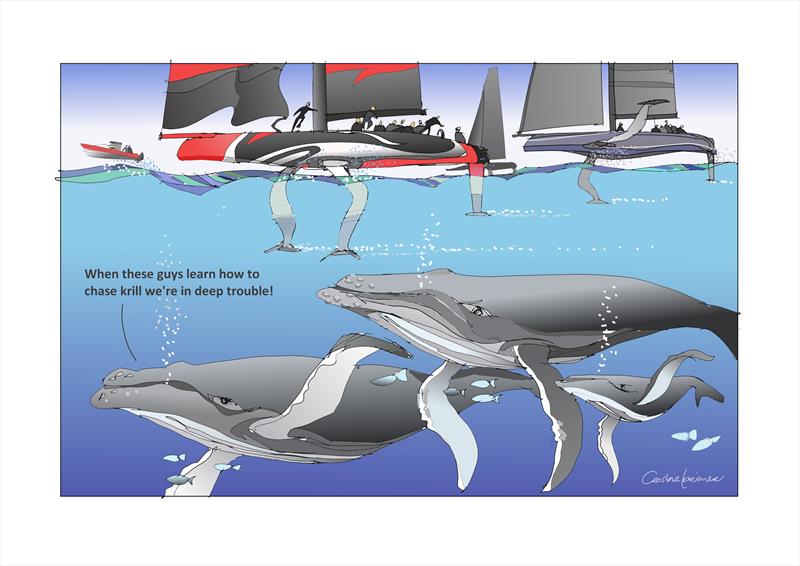
America's Cup: Four teams launch four AC75s - who's right?
by America's Cup Media 12 Oct 2019 14:57 PDT
12 October 2019

And when whales work out how to foil © Bow Caddy Media
After 18 months of heavy secrecy shrouding anything to do with the AC75s, the 75 foot foiling monohull is quickly becoming an open affair with two new boats unveiled last week less than 48 hours apart. This brings the total to four and provides us with plenty of opportunity to analyse the differences that are already apparent.
On the 3rd of October, the Italians of Luna Rossa Prada Pirelli Team were the third team to launch their boat after the Defender Emirates Team New Zealand and the USA Challenger NYYC American Magic. The Italian boat was christened 'Luna Rossa' by Miuccia Prada, CEO of the Prada Group together with her husband Patrizio Bertelli, during a ceremony at the team's home base in Cagliari, Sardinia - the venue for the first America's Cup World Series event next April.
A couple of days later in Portsmouth (UK), Julia Ratcliffe, the daughter of the syndicate owner Jim Ratcliffe, did the honours to name INEOS Team UK's AC75 'Britannia' in homage to one of Britain's most famous racing yachts.
As the Protocol of the 36th America's Cup doesn't allow the teams to shroud their boats, the new 75' monohulls were quickly snapped and "grammed" around the world for everyone - teams and fans - to comment and draw their first conclusions.
The new launches have only added to the diversity of Emirates Team New Zealand and NYYC American Magic's interpretation of the AC75 Class Rule, confirming once again the high level of freedom allowed by the current design rules.
Design teams have spent a lot of time exploring different hull shapes within the Class Rule limits, looking for a shape with minimal drag in light-wind displacement mode while also addressing the stability required to generate thrust for take-off.
With the hull having no significant limits on structure other than a handful of standard AC rule limits, the shape of the hull is where the differences are most evident.
In broad terms it's possible to pair the four boats with the Kiwis and the Italian choosing one approach and INEOS TEAM UK and American Magic going in another direction. However, experts may consider pairing the boats too simplistic. So what has been revealed so far that's out there for everyone to see?
INEOS Team UK's hull shape is probably the most radical in appearance; while the bottom has a very clean scow like line - similar to NYYC American Magic and opposite to Emirates Team New Zealand and Luna Rossa - the deck layout has a completely new design, with a very flat and low bow, slab sides and a straight sheerline toward the stern.
The British hull seems wider, with the foil rotation points (whose distance is fixed as per the Class Rule) appearing to be inside the hull compared to the other teams that have a dimple treatment where the carbon foil arms stick out from the hull.
Luna Rossa Prada Pirelli's design has gone in the opposite direction with a boat similar but more radical than the Defender's. Despite a more traditional bow - that gives a nod to those of the old America's Cup boats - the sheerline is quite pronounced and tapers towards the transom. The bottom has a rounded-V structure in the centre ending just ahead of the rudder.
What the four AC75's have in common is the cockpit where they are all divided in two by a central extension to the forward deck, creating two pits for the crew, all with variations to the layout, which will lead to interesting comparisons of crew dynamics while sailing for each of the teams.
In foil world, it was interesting to notice that both Luna Rossa and Britannia have also opted for a tapered central bulb similar to Defiant, leaving the Defender the only team going "against the tide" in that aspect of foil design. But there the similarities end. INEOS TEAM UK appear to have bigger wings and two different foil shapes per side, whereas Luna Rossa Prada Pirelli have the smallest wings seen so far and, although it is not possible to know what is happening at a systems level, their shapes look very much alike.
Last but not least the approach to regulate the new double mainsail concept showed some significant differences with Luna Rossa Prada Pirelli appearing to have the most intriguing system so far.
As declared at the Luna Rossa launch "the boom is there but you can't see it", which made everyone think the Italians won't have a standard boom. Britannia has been launched without her mast, so it is not possible yet to determine what solution they have opted for.
There is still much more to be revealed, for example nothing has been - nor will be - revealed about the highly sophisticated flight-control systems that will be key in the performance of these boats.
Syndicates are allowed to build two boats and this first generation will be a major testing platform for the second generation which will be raced in Auckland. The question is, will we see such a diverse spread of designs across the second iterations of each teams AC75's?
The premiere America's Cup World Series event in Cagliari will provide the first real opportunity by which teams can measure themselves and their first boats against each other to see who has chosen the best path so far. In the meantime, Syndicates can only rely on their recon reports to gather information, analyse data and feed the findings into the design of their second boat as the construction of the second generation of AC75s is just few months away.
For the full story and videos click here
For a quick run-through of the AC75 click here